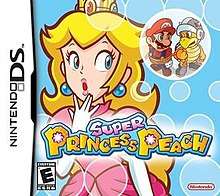Super Princess Peach
| Super Princess Peach | |
|---|---|
 North American box art | |
| Developer(s) | Tose |
| Publisher(s) | Nintendo |
| Director(s) |
Akio Imai Azusa Tajima |
| Producer(s) |
Shigeru Miyamoto Yasuhiro Minamimoto Hitoshi Yamagami |
| Designer(s) | Takayuki Ikeda |
| Composer(s) | Akira Fujiwara |
| Series | Mario franchise |
| Platform(s) | Nintendo DS |
| Release | |
| Genre(s) | Platforming |
| Mode(s) | Single-player |
Super Princess Peach (スーパープリンセスピーチ Sūpā Purinsesu Pīchi) is a platform video game developed by Tose and published by Nintendo for the Nintendo DS handheld game console. It was released in Japan in October 2005, and worldwide the following year. The first in the Mario series of games to feature Princess Peach as the main playable character, Super Princess Peach follows the titular character as she ventures to Vibe Island in order to rescue Mario and Luigi, who have been kidnapped by Bowser, in a reversal of the damsel in distress trope.
First announced by Nintendo in 2004, Super Princess Peach was released in Japan in October 2005 and later elsewhere in 2006. The game was praised for constituting a role reversal of the plot typically used in Super Mario games, while criticism was directed towards the low difficulty and Peach's method of attacking. Critics also noted the game's marketing campaign, questioning whether or not if catered towards stereotypical female interests. It sold 1.15 million units worldwide.
Gameplay

Super Princess Peach plays similarly to traditional platformers. There are eight worlds, each of which contain six levels and a boss battle which leads the player to the next world. Each boss battle requires playing a short minigame that makes use of the DS's touchscreen. Three captive Toads are hidden throughout each level, with each boss battle holding a single Toad being contained in a bubble. In order to play the final boss battle, the player must rescue all of the Toads.
After the game is completed, the player can go through the levels again to pick up more unlockable items. Beating a boss will unlock three new levels for the next world; for instance, beating the World 1 boss will unlock three new levels for World 2 and so on. There are a total of 24 extra levels to unlock.
On the upper left hand side of the screen, there are two bars: heart gauge (maximum of five hearts) and emotion meter. Whenever Peach falls down a hole, an ocean of lava or gets hit by an enemy, she loses half a heart and respawns at the last checkpoint. When all hearts are gone, she must start over at the beginning of the level. Peach has infinite lives, so the player can continue as much as he/she pleases.
The emotion meter corresponds to the four vibe powers she has. The emotions at Vibe Island affect everybody, even some enemies, but Peach can change her emotions at will. The four emotions are joy, gloom, rage, and calm. When the player taps on each mood, it will activate a different ability, which typically helps solve puzzles or defeat enemies.
Each use will drain the player's vibe meter. The bar can be restored by capturing blue turquoise jewels or absorbing enemies.
Unlike Mario, jumping on enemies does not defeat them; Peach must use Perry the Parasol to hit them. The player can press "B" to immediately sweep them aside or "X" to put them on top of the umbrella. Once an enemy is on top of the umbrella, the player may press "X" again to put the enemy down, "B" to throw the enemy, or down on the D-pad to absorb the enemy, which refills part of the emotion meter.
As the game progresses, Perry the Parasol gains new abilities. The "Subrella" allows Peach to travel underwater. The player blows into the microphone to blow bubbles to defeat the undersea enemies and break blocks. The "Slidebrella" turns Perry upside down and uses his handle like a hook. It is used in areas with a maze of high-flying wires. The "Bowlbrella" puts Peach in the umbrella and allows her to navigate through the water's surface.
In addition, the game features a shop where players can buy items, using coins as currency. The player can buy increment upgrades to expand the heart gauge or the emotion meter, as well as three new abilities. The "Floatbrella" allows Peach to stay afloat for a few seconds. "Poundbrella" shakes the ground and stuns any enemies nearby. "Chargebrella" creates a small charge that will stun the closest enemy. She can also extend her health and vibe meters, as well as earn coins from attacking enemies.
The game's bonuses include a glossary, puzzles, mini games, a music room, and replays of Perry's dreams. There are three mini games within the game and the levels are unlocked as the player finds more mini game pieces in the levels. All of the mini games has the player control Toad in a variety of activities (such as a platforming mode).
Plot
Near the location of the Mushroom Kingdom, a fabled land known as Vibe Island is said to hide a treasure known as the Vibe Scepter, a magical weapon that can be used to control the emotions of other people. Hearing of the island's legendary powers, Bowser builds a Summer getaway home on the island in hopes of using it to his advantage. After eventually finding the Scepter, Bowser sends his minions to Princess Peach's castle to capture the Mario Brothers. With the residents of the castle under the influence of the Scepter, the Hammer Bros. successfully capture Mario, Luigi, and Toad, but Toad escapes and retreats to the Mushroom Kingdom. Meanwhile, Princess Peach and Toadsworth return to her castle after a short walk only to discover a note from Bowser saying that he has captured Mario and Luigi. Enraged, Peach decides she is the only one who can rescue the Mario Brothers and sets out to go to Vibe Island. Shortly before her departure, Toadsworth, who is reluctant to see Peach travel on her own, gives Peach a sentient parasol named Perry to help her on her journey. With Perry now on her side, Peach finally sets out for Vibe Island to rescue Mario and Luigi.
As the duo venture through the various worlds, Perry's backstory is revealed in the form of several flashbacks; long ago, Perry was an young man with magical powers, and was adopted by an old man who he came to call "Grandpa". Later, Perry transformed himself into an umbrella and was captured by a wizard and his henchman, but managed to escape by wiggling free from his captors and fell on the road. Sometime later, a traveling merchant found him and sold him to Toadsworth.
Peach and Perry battle through eight worlds, rescuing various Toads along the way. After defeating Giant Kamek, the seventh world's boss, they free Luigi from the bubble Kamek captured him in. Peach and Perry arrive at Bowser's Villa, where they battle and defeat Bowser along with his Hammer Bros. Bowser uses the Vibe Scepter to turn into a giant, but Peach and Perry defeat him once again by throwing Bob-ombs at him and whacking him out of the villa with the Scepter in hand. After Bowser's defeat, Peach enters the villa and frees Mario, after which they rejoice and return to the Mushroom Kingdom alongside Luigi and the Toads, with the fate of the Vibe Scepter left unknown.
Release
Super Princess Peach was first announced by Nintendo in October 2004 with the exclusion of a posted release date.[1] It was first released in Japan on October 24th, 2005.[2] after It later came out in North America[3] and Europe[4] on February 27th and May 26th, 2006, respectively.
Reception
| Reception | ||||||||||||||||||||||||||||||||||||||||||
|---|---|---|---|---|---|---|---|---|---|---|---|---|---|---|---|---|---|---|---|---|---|---|---|---|---|---|---|---|---|---|---|---|---|---|---|---|---|---|---|---|---|---|
| ||||||||||||||||||||||||||||||||||||||||||
Super Princess Peach received generally positive reviews from critics, it currently has an average rating of 76.60% on GameRankings,[5] and of 75% on Metacritic.[6]
The game's lack of difficulty was intensely criticized. Gaming website GameSpy noted that the number of shop items and the "Joy" vibe made it "quite hard to die".[15] Another web site, IGN, was more critical, criticizing Nintendo for "going out of its way" to "spoon-feed" the player full of tips and information.[18] Reviewer Ryan Davis from GameSpot similarly wrote that the game was "way too easy for the average platformer player."[14] X-Play's Morgan Webb gave it a 4/5, commenting that the game was very easy to play and should be played by first timers to platform games.[21]
The nature of the vibes and Nintendo's marketing campaign were also noted in some reviews. Davis accused Nintendo of putting "weird sexist undercurrents" into the game,[14] while GameSpy's Bryn Williams wondered if Nintendo was trying to say that all females were "emo".[15] Craig Harris from IGN said that the copy that Nintendo sent to him came in a box scented with perfume.[18]
As of July 25, 2007, Super Princess Peach has sold 1.15 million copies worldwide.[22]
References
- ↑ http://www.ign.com/articles/2004/10/29/princess-peach-gets-nds-game
- ↑ http://www.ign.com/articles/2005/10/24/now-playing-in-japan-33
- ↑ https://www.gamespot.com/articles/dses-now-feeling-peachy/1100-6144990/
- ↑ https://www.gamespot.com/articles/nintendo-announces-european-release-schedule/1100-6151400/
- 1 2 "Super Princess Peach for DS". GameRankings. Retrieved October 23, 2013.
- 1 2 "Super Princess Peach Critic Reviews for DS". Metacritic. Retrieved 2013-10-23.
- ↑ Parish, Jeremy (2006-02-27). "Super Princess Peach Review". 1UP.com. Archived from the original on 2011-06-04. Retrieved 2013-10-23.
- ↑ "Super Princess Peach Overview". Allgame. Retrieved 2009-03-18.
- ↑ Kumar, Mathew (2006-03-07). "Super Princess Peach Review". Eurogamer. Retrieved 2009-03-18.
- ↑ "NDS Games - Famitsu Scores Archive". Famitsu Scores Archive. Archived from the original on 2008-09-02. Retrieved 2013-10-23.
- ↑ "Super Princess Peach". Game Informer: 118. March 2006.
- ↑ "Review: Super Princess Peach". GamePro. February 27, 2006. Archived from the original on 2009-12-08. Retrieved 2009-03-18.
- ↑ Dodson, Joe (2006-02-24). "Super Princess Peach Review". Game Revolution. Retrieved 2013-10-23.
- 1 2 3 Davis, Ryan (February 24, 2006). "Super Princess Peach Review". GameSpot. Retrieved October 23, 2013.
- 1 2 3 Williams, Bryn (February 27, 2006). "GameSpy: Super Princess Peach Review". GameSpy. Retrieved October 23, 2013.
- ↑ Elston, Brett. "Super Princess Peach Review". GamesRadar. Retrieved 2013-10-23.
- ↑ David, Mike (2006-04-12). "Super Princess Peach Review". GameZone. Retrieved 2009-03-18.
- 1 2 3 Harris, Craig (February 23, 2006). "Super Princess Peach". IGN. Retrieved October 23, 2013.
- ↑ Shughart, Ty (November 24, 2005). "Super Princess Peach Review". Nintendo World Report. Retrieved 2013-10-27.
- ↑ East, Tom (10 January 2008). "DS Review: Super Princess Peach". Official Nintendo Magazine. Retrieved 2013-10-23.
- 1 2 "Review: Super Princess Peach". X-Play. Archived from the original on 2017-08-06. Retrieved 2009-03-18.
- ↑ Matt Casamassina (2007-07-25). "Nintendo Sales Update". IGN. Retrieved 2013-10-23.
External links
- Official website
- Super Princess Peach at Nintendo.com (archives of the original at the Internet Archive)
